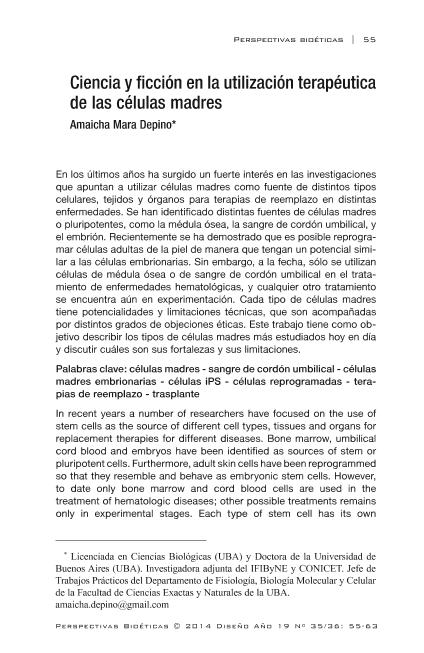Artículo
En los últimos años ha surgido un fuerte interés en las investigaciones que apuntan a utilizar células madres como fuente de distintos tipos celulares, tejidos y órganos para terapias de reemplazo en distintas enfermedades. Se han identificado distintas fuentes de células madres o pluripotentes, como la médula ósea, la sangre de cordón umbilical, y el embrión. Recientemente se ha demostrado que es posible reprogramar células adultas de la piel de manera que tengan un potencial similar a las células embrionarias. Sin embargo, a la fecha sólo se utilizan células de médula ósea o de sangre de cordón umbilical en el tratamiento de enfermedades hematológicas, y todo otro tratamiento sólo está en etapas de experimentación. Cada tipo de células madres tiene potencialidades y limitaciones técnicas, que son acompañadas por distintos grados de objeciones éticas. Este trabajo tiene como objetivo describir los tipos de células madres más estudiados hoy en día y discutir cuáles son sus fortalezas y sus limitaciones. In recent years a number of researchers have focused on the use of stem cells as the source of different cell types, tissues and organs for replacement therapies for different diseases. Bone marrow, umbilical cord blood and embryos have been identified as sources of stem or pluripotent cells. Furthermore, adult skin cells have been reprogrammed so that they resemble and behave as embryonic stem cells. However, to date only bone marrow and cord blood cells are used in the treatment of hematologic diseases; other possible treatments remains only in experimental stages. Each type of stem cell has its own potential and technical limitations, and its use raises different kinds of ethical concerns. The aim of this article is to describe the types of stem cells mostly studied today and to discuss their strengths and limitations.
Ciencia y ficción en la utilización terapéutica de las células madre
Fecha de publicación:
06/2014
Editorial:
Facultad Latinoamericana de Ciencias Sociales
Revista:
Perspectivas Bioéticas
ISSN:
1575-8443
Idioma:
Español
Tipo de recurso:
Artículo publicado
Clasificación temática:
Resumen
Archivos asociados
Licencia
Identificadores
Colecciones
Articulos(IFIBYNE)
Articulos de INST.DE FISIOL., BIOL.MOLECULAR Y NEUROCIENCIAS
Articulos de INST.DE FISIOL., BIOL.MOLECULAR Y NEUROCIENCIAS
Citación
Depino, Amaicha Mara; Ciencia y ficción en la utilización terapéutica de las células madre; Facultad Latinoamericana de Ciencias Sociales; Perspectivas Bioéticas; 19; 35-36; 6-2014; 55-63
Compartir
Items relacionados
Mostrando titulos relacionados por título, autor y tema.
-
Marotte, Clarisa ; Zeni, Susana Noemi (Federación Bioquímica de la Provincia Buenos Aires, 2013-08)
-
Pardo, Joaquin; Sosa, Yolanda Elena ; Reggiani, Paula Cecilia ; Arciniegas, M. I.; Sanchez, Francisco Homero ; Goya, Rodolfo Gustavo (Federacion Bioquimica Provincia Buenos Aires, 2013-06)
-
Cabrera, Gabriel Gustavo ; Mundiñano, Juliana ; Camicia, Gabriela Lorena ; Costa, Hector Luis ; Nepomnaschy, Irene ; Piazzon, Margarita Isabel (Medicina (Buenos Aires), 2011-03)




